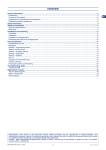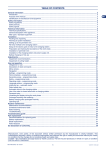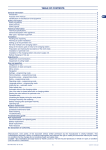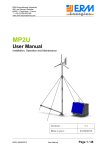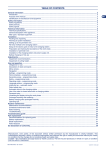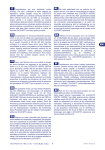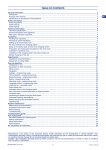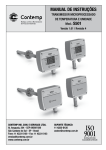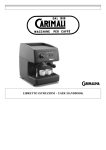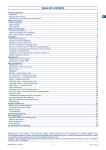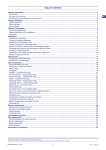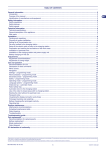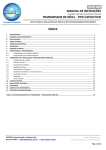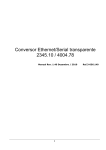Download NemH2O Manual - LawnBotts.com
Transcript
overview EN General information.����������������������������������������������������������������������������������������������������������������������������������������������������������������������2 Introduction.�����������������������������������������������������������������������������������������������������������������������������������������������������������������������������������2 Purpose of the manual.������������������������������������������������������������������������������������������������������������������������������������������������������������������2 Identification of manufacturer and equipment.�������������������������������������������������������������������������������������������������������������������������������3 Requesting technical assistance.���������������������������������������������������������������������������������������������������������������������������������������������������3 Safety information.�������������������������������������������������������������������������������������������������������������������������������������������������������������������������3 Technical information.�������������������������������������������������������������������������������������������������������������������������������������������������������������������4 Technical specifications.����������������������������������������������������������������������������������������������������������������������������������������������������������������4 Main parts.�������������������������������������������������������������������������������������������������������������������������������������������������������������������������������������5 Installation and unpacking.�����������������������������������������������������������������������������������������������������������������������������������������������������������6 Unpacking.�������������������������������������������������������������������������������������������������������������������������������������������������������������������������������������6 Installation.�������������������������������������������������������������������������������������������������������������������������������������������������������������������������������������6 Installation of charging base.���������������������������������������������������������������������������������������������������������������������������������������������������������6 Positioning the robot in the charging base.������������������������������������������������������������������������������������������������������������������������������������9 Use and operation.�����������������������������������������������������������������������������������������������������������������������������������������������������������������������10 Requirements for use.������������������������������������������������������������������������������������������������������������������������������������������������������������������10 Navigation.�����������������������������������������������������������������������������������������������������������������������������������������������������������������������������������10 Settings - programming mode.�����������������������������������������������������������������������������������������������������������������������������������������������������11 Setting - working times.����������������������������������������������������������������������������������������������������������������������������������������������������������������11 Settings - language options.��������������������������������������������������������������������������������������������������������������������������������������������������������12 Settings - diagnostics.������������������������������������������������������������������������������������������������������������������������������������������������������������������12 Settings - statistics.����������������������������������������������������������������������������������������������������������������������������������������������������������������������12 Set up.������������������������������������������������������������������������������������������������������������������������������������������������������������������������������������������12 Using the communication box.�����������������������������������������������������������������������������������������������������������������������������������������������������12 Ordinary cleaning.������������������������������������������������������������������������������������������������������������������������������������������������������������������������13 Prolonged inactivity and restarting.����������������������������������������������������������������������������������������������������������������������������������������������14 Troubleshooting guide.����������������������������������������������������������������������������������������������������������������������������������������������������������������15 Troubleshooting.��������������������������������������������������������������������������������������������������������������������������������������������������������������������������15 Replacement of parts.������������������������������������������������������������������������������������������������������������������������������������������������������������������16 Tips on replacing parts.����������������������������������������������������������������������������������������������������������������������������������������������������������������16 Battery replacement.��������������������������������������������������������������������������������������������������������������������������������������������������������������������16 Robot disposal.����������������������������������������������������������������������������������������������������������������������������������������������������������������������������16 Reproduction, even partial, of this document without written permission by the manufacturer is strictly forbidden. The manufacturer assumes a policy of continual improvement and reserves the right to modify this document without prior notice on condition that the changes do not constitute health and safety risks. © 2008 – Texts, illustrations and page layout: Tipolito La Zecca. The text may be reproduced, in whole or in part, on condition that the author is mentioned. User manual 1 MD-CT-RO-31-R2.0 - EN - 09-2014 General information Introduction EN Congratulations on purchasing this product, which we are certain will meet your needs and expectations. This project was created by ZUCCHETTI CENTRO SISTEMI S.p.A. (UNI EN ISO 9001 certified company), a software house that since 1982 has consolidated its activities and presence on the international market. Applying advanced IT solutions in the field of industrial automation means optimising the production activities and simplifying the work procedures. This product was created on the basis of on-going research by ZUCCHETTI’s laboratories. Purpose of the manual • This manual forms an integral part of the appliance and was produced by the Manufacturer to provide the necessary information to people authorised to interact with it during its working life. • Operators of the appliance must adopt correct working practices and must carefully read and follow all the instructions contained in this manual. • This manual was written by the Manufacturer in the original language of Italian and may be translated into other languages to meet legal and/or commercial requirements. • Carefully read the instructions contained in this manual to avoid any unnecessary risks to people’s health and safety, as well as economic damages. • Keep this manual in a safe and easily accessible place for quick reference. • Some information and illustrations contained in this manual may not perfectly correspond with the appliance in your possession; however, this will not affect its functioning. • The Manufacturer reserves the right to make changes at any time, without notice. • The following symbols are used throughout this manual to highlight some particularly important information or identify some important specifications. Danger - Attention This symbol indicates situations involving imminent danger, which, if ignored, could put people’s health and safety at risk. Warning - Caution This symbol indicates situations where it is necessary to behave in a certain way in order to avoid putting people’s health and safety at risk, and to protect the device. Important This symbol identifies particularly important technical information that must not be ignored. User manual 2 Identification of manufacturer and equipment EN The identification plate shown here is applied directly onto the appliance. It contains references and all the information essential for the safe operation of the device. DATA PLATE (A) Name of manufacturer (D) Technical specifications A.Name of manufacturer. (C) Serial number B.CE conformity label Zucchetti Centro Sistemi S.P.A Via Lungarno 305/A - 52028 Terranuova B.ni (AR) C.Model / serial number / manufacturing year. 00000000000000000 D.Technical specifications: voltage, current, protection rating, mass. 0000 (C) Model (B) EC conformity label (C) Manufacturing year Requesting technical assistance For any technical requirements, please contact the Manufacturer’s Technical Service Centre or an authorised dealer. For technical assistance, please indicate the data reported on the identification plate, the approximate hours of use and the type of fault detected. Safety information SAFETY RULES • During design and construction, the manufacturer carefully considered the possible hazards and personal risks that may result from interacting with the equipment. In addition to complying with the applicable laws in force, the manufacturer adopted all the “good manufacturing practice regulations.” The purpose of this information is to inform users on the need to use extreme caution to avoid risks. • Before use, carefully read the whole manual and be sure to understand it fully, especially the safety information. • Only use the equipment for the purposes specifically intended by the manufacturer. Improper use of the equipment may be hazardous to personal safety and health and may lead to economic losses. Keep in mind that the operator or user is responsible for accidents or danger to other people or their property. • This appliance cannot be used by people (including children) with limited physical, sensorial or mental abilities and little experience and/or know-how, unless they are supervised by a person responsible for their safety or have received instructions on how to use the appliance. Children should be supervised to ensure that they do not play with the appliance. • If the power supply of the transformer is damaged, it must be replaced by the manufacturer or by its technical service centre or by a person with similar qualifications, in order to avoid any risk. • Always position the power supply unit at a minimum distance of 3 metres (10 feet) from the edge of the pool, in a dry, wellventilated area. Position the power supply unit in an area that cannot be reached by children. For example, at a height above 160 cm (63 inches). • Never remove, bypass or tamper with the safety devices installed. The failure to comply with this requirement may pose serious risks to the health and safety of people. • Operators who perform repairs during the working life of the robot must have the necessary technical expertise, skills and experience in this specific field. The failure to comply with these requirements may be hazardous to the health and safety of people. • Any work to be performed on the charging station must be carried out with plug of the power cord disconnected. • The robot cannot be used without the top cover. If the mechanical parts of the robot are damaged, replace them. User manual 3 EN • The Manufacturer shall not be held liable if unoriginal spare parts are used. • Never use and recharge the robot in explosive and/or flammable environments. • Only use the battery charger and power supply unit supplied to recharge the robot. Improper use can cause electric shocks, overheating or leakage of corrosive liquid from the battery. In case of leakage, the battery must be washed with water/ neutraliser; in case of contact with eyes, consult a physician. Technical information Technical specifications Model Description 045BA0 Robot dimensions (W x H x D) mm 410 x 320 x 460 Weight Kg 21 Ambient operating temperature Water protection class IP Maximum pool depth cm Maximum recharging base depth ROBOT 5°(Min) +35°(Max) Max °C BATTERY CHARGER -10°(Min) +40°(Max) ROBOT - IP68 BATTERY CHARGER - IP64 500 cm 500 pH: 7.0-7.8 Temperature: 5-35°C NaCl Max: 5,000 ppm Chlorine Max : 4 ppm Water, operating parameters Vin 100 - 240Vac. Input Frequency range 50-60. Vout 36Vcc - 5,0A. Power Supply unit Battery Lithium Ion - 25,2V - 13.8Ah Avg. working time hh:mm 2:00 Avg. recharging time hh:mm 3:00 Travelling speed on the bottom Mt/min. 10 - 20 Travelling speed on the wall Mt/min. 8 Filters 2 Litres, mesh pitch of 0.5mm Tablet/Console included Communication Box optional Smooth wall kit optional Adapter for curves between the wall and bottom optional User manual 4 Main parts 1. Robot. EN 2. Robot hook: for lifting the robot out of the water (pole not included). 3. Charging hook: for securing the charging cord immersed in the water. 4. Robot recharger: for recharging the robot in the water. 5. Power Supply unit: powers the recharging of the robot. 6. Tablet/Console: it allows you to programme the robotic cleaner settings and consult the user manual. 2 6 4 3 1 5 7. Communication Box: Not included in the kit. Device to be installed between the power supply unit and robotic cleaner recharging base. It allows you to recall the robotic cleaner to the recharging base or enable it to operate even if it is not within the set working time band. 8. Smooth wall kit: Not included in the kit. Kit to be applied to the wheels in the presence of smooth walls which prevent the robotic cleaner from climbing up them. 9. Adapter for curves between the wall and bottom: Not included in the kit. Allows the installation of the robotic cleaner recharging base in swimming pools that are curved between the wall and bottom, distancing the recharging base up to 20 cm from the wall so it can detect the bottom. The adapter also allows you to manage non-horizontal bottoms. 9 7 8 User manual 5 Installation and unpacking Unpacking EN The equipment is delivered suitably packaged. When unpacking, carefully remove and check the integrity of the parts. The packaging contains all the necessary information for handling the device. Installation • Remove the robot from the packaging. • Place the robot on the ground. • Install the charging base and then gently immerse the robot in the pool. Wait until it has settled on the bottom and then, using the hook provided, place the robot near the charging plate from the front side of the robot, which is identified by a recharging sticker. If positioned correctly, the leds of the recharger will light up continuously. • Recharge the robot for 15 minutes before moving to the programming phase. • To program the robot, take it out of the water using the hook provided, place it on the ground and follow the programming instructions. The programming only works with the robot out of the water. • Once programmed, immerse the robot in the water so that the work cycle can begin. Installation of charging base Remove the charging base from its packaging. Place the charging base along the vertical wall of the pool. Important -- Position the steel side of the dissipator in contact with the pool wall. -- Do not position the charging base on the bottom of the pool. -- Make sure that the angle formed between the charging base and the opposite bottom is 90° and that the area surrounding the recharger (at least 2 meters) is even and horizontal. Alternatively, use the provided adapter for curves between the wall and bottom. -- The depth of the bottom where the recharging base is positioned shall be a maximum of 5 metres. OK User manual OK NO 6 NO Here are some examples of where the charging base can be installed and where it cannot be installed: Left 2. in case of bottoms with level differences or steps, place the charging base on the opposite wall. Observe the above-mentioned distances. Left Centro 30cm Right Right 30cm Centre Centre OK Centre ≥ 300 cm 30cm 30cm 30cm Right Centre OK Left Right Left EN 1. position the wire of the charging base 30 cm from the corner of the wall. It can be installed approximately in the centre of the wall of the swimming pool at a distance of at least 3 meters from the angle of the side wall on the left of the recharging base. Left 30cm Right 3. do not place the charging base under or near a ladder. Centre 4. do not place the robot near steps. The robot may find it difficult to return to the charging base. NO NO 5. do not place the charging base on the wall near a level difference. 6. do not place the wire of the charging base less than 30 cm from the corner. Do not place the recharging base in the angle of the walls. It must be installed in contact with one of the vertical walls of the swimming pool. Do not place the recharging base under or near the stairs. NO NO User manual Left 7 After positioning the charging base, fasten the cord to the edge of the pool. Here are some examples of pool edges with installation of the charging hook. The cord can be installed along the edge or on the ground next to the pool, as long as there is an eyelet or a loop in each of these points on which to fasten the hook. EN Warning - Caution -- Position the power supply unit in an area that cannot be reached by children. For example, at a height above 160 cm (63 "). -- When connecting the electricity, make sure a power outlet is positioned near the installation area. Make sure the connection to the mains power complies with the applicable laws. To operate in complete safety, make sure the electrical system, which is connected to the power supply unit, is equipped with a wellfunctioning earthing system. -- Make sure only authorised people have access to the power supply. Important It is advisable to install the unit in a cabinet for electric components (for outdoor or indoor use), well ventilated to maintain correct air circulation and fitted with a key lock. Connect the cord to the power outlet. Connect the power unit to the mains electricity supply. Min. 160 cm User manual 8 Positioning the robot in the charging base EN Gently immerse the machine in the water. Attach the retrieving hook on the pole to clean the pool (not included). Using the retrieving hook supplied, bring the recharging side (identified by a sticker affixed to the body of the robot) in contact with the plate of the charging base. Danger - Attention The first charging of the robot does not have to be performed out of the water. Simply bring it close to the charging station for a few minutes. This operation allows waking the robot from stand-by mode and programming it. Once the machine has been placed on the charging base, check that the leds are on and steady. If one of the three lights is off or flashing, consult the TROUBLESHOOTING section. On first use, leave the robot to recharge for at least 15 minutes, then retrieve the robot using the hook supplied and remove it from the water. Program the settings using the remote console. If the robot has already been programmed, it will start its work cycle within the scheduled time once the batteries are charged. Uso e funzionamento User manual 9 Use and operation Requirements for use EN Important -- When using the robot for the first time, carefully read the whole manual and be sure to fully understand it, especially the safety information. -- Only use the robot for its intended purpose as described by the Manufacturer. Do not tamper with any device to obtain different operating performances. Important The programming only works with the robot out of the water. Important Proceed with the programming within 45 minutes; after this time, the robot goes back into stand-by mode. To reactivate, place it in the charging station. Navigation The menu has a tree structure. Follow the introduction containing a summary of the programming functions available. Details of each function are found in the pages following the flow diagram. Settings Percentage on bottom Indicates the percentage of time dedicated to cleaning the bottom of the pool 0..100% Recharging base Settings Return method Indicates the method used by the robotic cleaner to search for the recharging base Recharging base position Indicates the position of the recharging base on the left wall, in the centre, on the right wall Detection Indicates the recharging base detection level Follow pool edge Random Left Right Centre Standard High Low Travelling speed on the bottom Indicates the travelling speed along the bottom in metres per minute Date Sets the date Time Sets the time Week Allows adjusting the work days and rest days Work Schedule 1 Determines the first working time of the robot Work Schedule 2 Determines the second working time of the robot 10 - 20 Work schedules User manual 10 Language options EN Language Sets the language of the user menu Date format Sets the format for entering the date Time format Sets the format for entering the time DD/MM/YY MM/DD/YY 24H 12H Diagnostics Displays any errors occurring on the turbines, motors and boards Statistics Displays the statistics of the work performed by the robot Settings - programming mode Percentage on bottom: sets the percentage of time that the robot dedicates to cleaning the bottom of the pool. A value between 0% and 100% can be set. The higher the value set, the longer the time dedicated to cleaning the bottom. 100%: the robot only works on the bottom. 50%: the robot works half the time on the bottom and half the time on the wall. 0%: when the robot finds a wall, it will travel up it until reaching the water surface. Recharging base Settings: Return method: Indicates the method used by the robotic cleaner to search for the recharging base. Follow pool edge: Recommended method for regular shaped pools with the recharging base positioned on the “right” or “left”. Random: Recommended method for round, irregular shaped pools with narrow passages. In these cases, the recommended position for the recharging base is in the “centre”. Recharging base position: set the position of the recharging base on the wall, looking at the wall as if you were inside the pool. Left: indicates the position of the recharging base on the left side of the wall. Right: indicates the position of the recharging base on the right side of the wall. Centre: indicates the position of the recharging base in the centre of the wall. Detection: indicates the recharging base detection level. Standard: recommended settings. High: recommended for large swimming pools. Low: recommended when the recharging base is positioned in a narrow section. Travelling speed on the bottom: sets the travelling speed of the robot on the bottom in metres/minute. The higher the speed set, the more space the robot covers. Set low speeds in small pools in relation to the maximum capacity of the robot. Set high speeds in large pools or pools that dirty easily. Date: function for setting the date. Time: function for setting the time. Setting - working times Weekly: function for programming the working days of the robot during the week. On days with the flag “active,” the robot will perform the operating cycles according to the set working times. Work schedule 1: function for setting the first time slot of the robot’s working day. Set the start and end time of the working cycle. Setting the time at “00:00 – 00:00” means the robot will not work during work schedule 1. User manual 11 Work schedule 2: function for setting the second time slot of the robot’s working day. Set the start and end time of the working cycle. Setting the time at “00:00 – 00:00” means the robot will not work during work schedule 2. EN The setting of the time is essential for the robot’s proper functioning. Many parameters should be taken into consideration when setting the work time such as the size, shape, ease with which it gets dirty, frequency of use, etc. of the pool. As a rule, it is recommended to follow these rules: • program the robot activity while the cleaning system of the robot is running. Dirt removed by the turbines will then be filtered by the central system, improving the robot’s capacity. • start with a wide-ranging program and then reduce it when you are satisfied with the level of cleanliness. • program and leave the robot running every day. • check the filter of the robot. At first, very frequently, and then decrease the frequency in relation to the dirt found in the filter. Settings - language options Function for selecting the display language of the user and format menu that is used to set and display the date and time of the robot. Settings - diagnostics Displays any critical events or errors that occurred in the main components during the operation of the robot. If major errors occur, refer to the “Troubleshooting” chapter or contact the technical service centre. Settings - statistics Displays information on the work performed by the robot during its operation. Set up 1. Set and check the robot programming. 2. Check and clean the filters. 3. Place the robot inside the pool; refer to “Positioning robot in charging base”. 4. The robot starts is work cycle according to the settings programmed. Using the communication box The “Communication Box” allows you to recall the robotic cleaner to the recharging base or start it up even if it is not within the set working time band. Press the “HOME” button to recall the robotic cleaner to the recharging base, the “Battery” led will start to flash and the robotic cleaner will return to the recharging base when it acknowledges the recall command moving to the range of action of the recharging base itself. Press the “WORK” button or wait a few hours before starting the robotic cleaner again as per the standard operating settings. Press the “WORK” button and the robotic cleaner will perform a normal work cycle even if the current time is outside the set time band, the “Power” led will start to flash and the robotic cleaner will start the work cycle only if the batteries are sufficiently charged. On completing the work cycle, the robotic cleaner will return to the recharging base and start operating again as per the standard operating settings. User manual 12 Ordinary cleaning EN Clean the filter frequently, and then less frequently in relation to the dirt found in the filter. The frequency of cleaning depends on several factors: size of the pool, the ease with which it gets dirty, the frequency of use, etc. ----- Use the retrieving hook to bring the robot to the surface. Wait for the turbines to stop working. Remove the robot gently from the water, grasping it by the handle on the retrieving hook, and place it on the ground. Wait for it to emit four consecutive beeps to confirm that the robot is off. --- Unhook the fastening clips of the bonnet. Lift the bonnet and remove the filters to be cleaned. ------- Turn the closing clips to open the filter. If possible, clean the filter with the aid of a water hose. Close the filter. Place the filters inside the robot. Position the body and make sure all the clips are closed correctly. With the retrieving hook, gently place the robot inside the pool; refer to “Positioning robot in charging base”. Danger - Attention If the robot has been out of the water for more than one hour, it will go into standby. In this case, place the robot on the charging base, see “Positioning robot in charging base” to make it operational again. User manual 13 EN Prolonged inactivity and restarting If the robot has not been used for a long period of time, a series of operations must be performed to guarantee proper functioning at the time of reuse. 1. Remove the robot from the water when its batteries are fully charged. Usually, before the start of the first daily work cycle. Alternatively, disable the work times of the robot or the days of activity, and extract it after at least 4 hours of recharging. 2. Have routine maintenance performed by an authorised dealer. This is essential for keeping the robot in good working order. The assistance usually includes the following operations: • thorough cleaning of the robot, turbines, filters and all the moving parts. • checking of robot functioning. • checking and, if necessary, replacement of any worn parts such as filters, turbines, brushes. • checking of the battery capacity. • if necessary, the dealer can download the operating statistics, check for any faults and load any new software updates. 3. Thorough cleaning of the robot, turbines, filters and all the moving parts. 4. Check for any worn or damaged parts, such as filters, turbines, brushes and if necessary, replace. 5. Store the robot in a protected and dry place with an ambient temperature between 10° and 20° C, out of reach of children, pets, other foreign objects, etc. Store the robot at a temperature below 20°C in order reduce the automatic discharge of the batteries. 6. Disconnect the power plug from the power supply unit. 7. For correct maintenance of the batteries, recharge the robot at least every 5 months. Restarting Before restarting the robot after a long period of inactivity, proceed as follows. 1. Connect the plug of the power supply unit to the electrical outlet. 2. Reconnect the main electrical power supply. 3. Gently immerse the robot in the water and place it on the charging plate. If positioned correctly, the leds will light up continuously. 4. The robot is now ready for use. User manual 14 Troubleshooting guide Troubleshooting EN The information below is designed to help identify and correct any faults and/or malfunctions which may occur during operation. Read this guide before contacting the dealer. Problem Cause Remedies The robot has difficulty climbing up the walls Dirty filter Clean the filter The robot does not climb the wall or the walls are dirty Programming error Check the “Percentage on bottom” value in the user menu, and if necessary, set it at a higher value The robot has stopped in the pool without being recharged Recharging cannot be reached Check the programming of the re-entry side. Check that the recharging base has been positioned correctly. Check that the fastening hook of the charging cord is flush with the wall and that the recharger does not turn around itself. Check the filters and if necessary, clean. With the retrieving hook, position the robot in recharging mode, check that the leds are lit up and steady, wait until the batteries are charged. The robot will start its cycle only when the batteries are charged. Check that electrical power is being supplied to the power supply unit The robot does not start the work cycle Power supply unit is off Check that electrical power is being supplied to the power supply unit. Check the programming of the working days and times The recharging does not start No electrical power Check that electrical power is being supplied to the power supply unit The blue recharging led flashes when the robot is in the recharging position Wrong recharging side With the retrieving hook, turn the robot on the opposite side Programming error Check the setting and follow the programming recommendations for the parameters: • working days • working times • speed on the bottom • percentage on bottom The pool is dirty • Dirty filter The robot works a lot less than what is declared The robot does not start when immersed in the pool User manual Perform routine cleaning Dirty filter Perform routine cleaning The batteries are about to run out Contact an authorised Service Centre Discharged batteries With the retrieving hook, position the robot on the recharging base, check that the leds are lit up and steady, wait until the batteries are charged. The robot will start its cycle only when the batteries are charged 15 Replacement of parts Tips on replacing parts EN Important Replace and repair any parts according to the manufacturer’s instructions, or contact the service centre if these operations are not included in the manual. Battery replacement Important Replace the batteries at an authorised service centre. Robot disposal • At the end of its life cycle, this product is classified as WEEE (Waste Electrical and Electronic Equipment) and therefore cannot be disposed of as household waste, or as mixed municipal waste (unsorted), or separate municipal waste (sorted). • When disposing of the robot the user must ensure that it is recycled in accordance with the local requirements; in particular, the electrical and electronic components must be sorted and disposed of separately in special recycling collection centres authorised to collect WEEE, or the product must be returned still intact to the retailer when a new product is purchased. Unauthorised disposal of WEEE is punishable with fines governed by the laws in force in the country where the infraction took place. • The presence of hazardous substances in electrical and electronic equipment has a potentially harmful effect on the environment and on human health, therefore the user plays an important role in contributing to reuse, recycling and other forms of recovering WEEE. • All parts that must be collected, separated and disposed of in a specific manner are marked with a special label. Danger - Attention WEEE - Waste of Electric and Electronic Equipment may contain hazardous substances having potentially harmful effects on the environment and on human health. WEEE must be disposed of in the correct manner and only at authorised collection centres. • Packaging - The product packaging is made of recyclable materials and must be disposed of in a sustainable way in approved collection bins or at special authorised collection centres. • Batteries – Old or dead batteries contain substances harmful to the environment and to human health, therefore they must not be disposed of as normal household waste. The user must dispose of batteries in a sustainable way in approved collection bins or at authorised collection centres. User manual 16
















